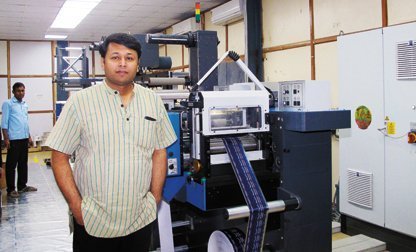
Noida-based Kumar Labels installed a 10-color Gallus EM 280 in September 2015. The new label press which features inline screen, cold foil, chilled rolls and one of the newest UV curing systems from IST, is installed at the company’s new 25,000 square-foot plant in Greater Noida. “The volume of many of our customers who were buying innovative labels from us increased and since we were executing several processes offline, our customers wanted us to produce longer runs in a single integrated operation and that was one of the purposes behind buying the Gallus,” says Anuj Bhargava of Kumar Labels and Hassle Free Technologies.
Kumar Labels’ sister concern company, Hassle Free Technologies, produces innovative labelstock. “We are running the new label press for about eight hours a day and at a speed which is sometimes higher than 120 metres a minute,” says Bhargava. The EM 280 provides a flexible and versatile combination of printing processes with short setup times for each job. It is easy to operate and has a quick-change platform for short changeover times, all of which makes it ideal for anyone starting out in either water-based or UV flex graphic printing.
Kumar Labels expects to post a growth rate of 15 to 20% in FY 2015-16. According to Bhargava, the label industry is shrinking in terms of revenue although it is expanding volume-wise. “To me that is really worrisome because if people like us don’t make sufficient profit, we would not be able to hire good talent and would not be able to invest in innovation or do any R&D and we would not be able to invest in new equipment either. It sounds very exciting to hear about printers buying Rs. 5 crore or Rs. 10 crore worth of new equipment but if you are running that equipment on a gross profit of 15%, what would be your net profit? You then earn a meagre 4% to 5% of net profit which is just a step away from being completely wiped out by a single major rejection.”
Hassle Free Technologies
But the adverse market situation has not been able to overcome the resilient Bhargava from doing things differently. “When we realized that gross margins are shrinking, we started looking at labelstock costs seriously. We found that the labelstock cost was actually 50 to 60% of our total costs. Thus, if we had not started producing our own labelstock it could be tricky to survive and this is what Hassle Free Technologies does,” says Bhargava. Currently, Hassle Free not only produces labelstocks for Kumar Labels but also exports to quite a few countries like Kuwait, Korea and Poland. “We are also supplying to some of our industry colleagues in India. Today our profitability has increased and we are able to pass on better price benefits to our customers.”
Managing innovation and winning patents
“By bringing Hassle Free technology into existence and by producing labelstock in-house, I would not say that it was only about controlling profits, but it was also about managing innovation. We already have two patents for innovative label stocks. One of the patented products has been in the market for almost two years.Our double-sided labelstock which is single release two faces (SRTF), is also in the market and should come in a big way in the next few months,” says Bhargava. Hassle free is supplies 80% of Kumar Labels’ requirement of labelstock and is the company’s largest customer. “The whole idea of a label is to decorate a product. It is about making a product beautiful. And I sincerely feel that the industry has forgotten about that and is unfortunately in a rat race of price cutting and gaining more market share and turnover. Sadly, the focus of making the product beautiful is getting lost. Kumar Labels’ main aim is to deliver more innovative products, make products beautiful in the market as well as offer customers a better price.”
Hassle free supplies 80% of Kumar Labels’ requirement of labelstock and is the company’s largest customer. Photo PSA
Facing the market sensibly
Bhargava says, the way to reduce cost should not be through reducing profits. The market is competitive and of course one must follow trends – but one must not follow a trend by losing money. “Produce your own stock, produce your own material, get control over your balance sheet and don’t be too dependent on very large corporations for buying your raw materials. Prefer not to be dependent on any supplier for more than a certain percentage of your purchase, and don’t be dependent on any customer for beyond a certain percentage of your sales,” says Bhargava. “I don’t want one very large customer who occupies 90% of my capacity. Because problems do happen and people change as well as products change. We were producing a certain label that used to give us huge amount of revenue. Suddenly it changed to shrink sleeves – so what could you do then?”
Packaging South Asia is the cooperating media partner for drupa 2016 which is scheduled to be held from 31 May to 10 June at Dusseldorf, Germany.







